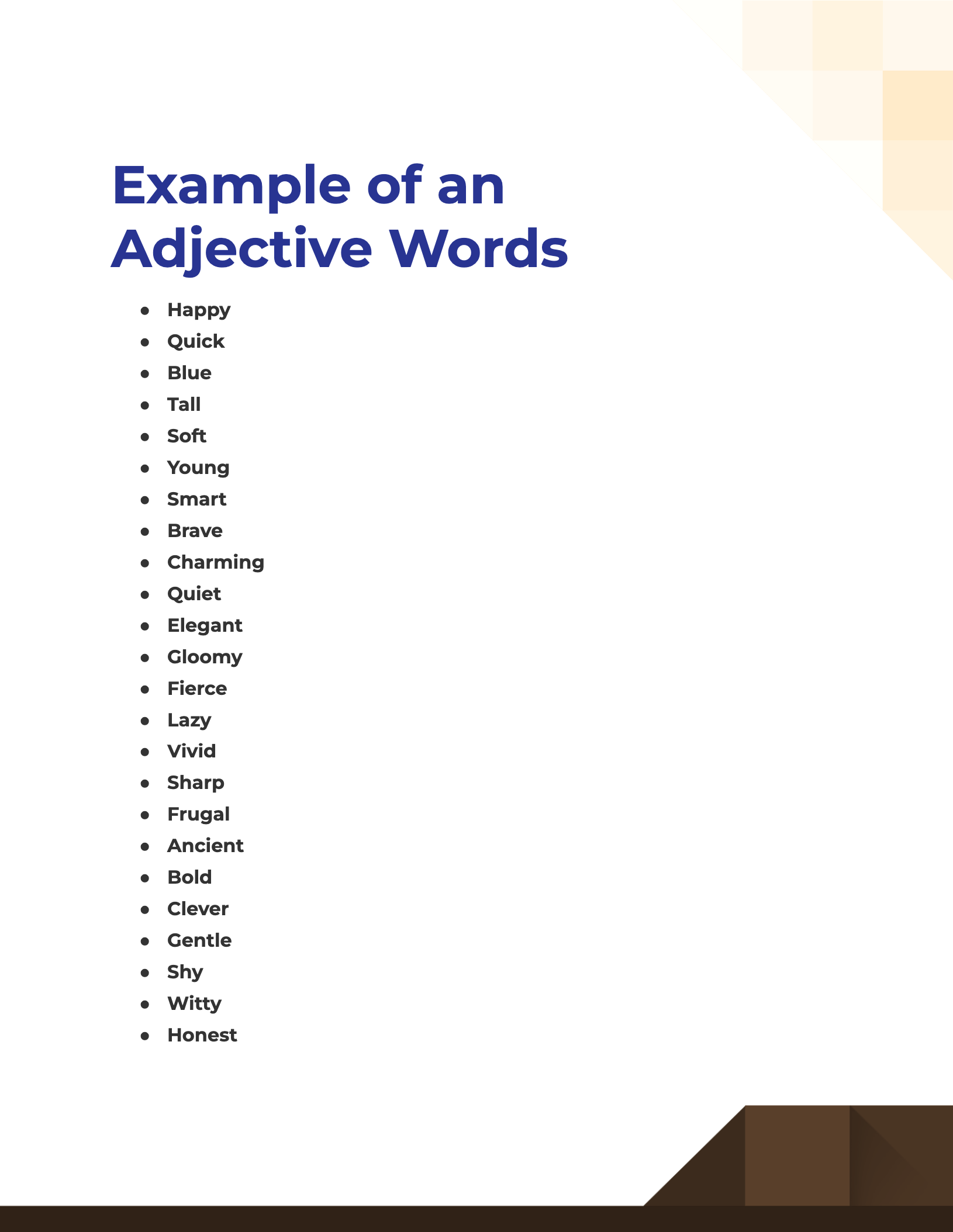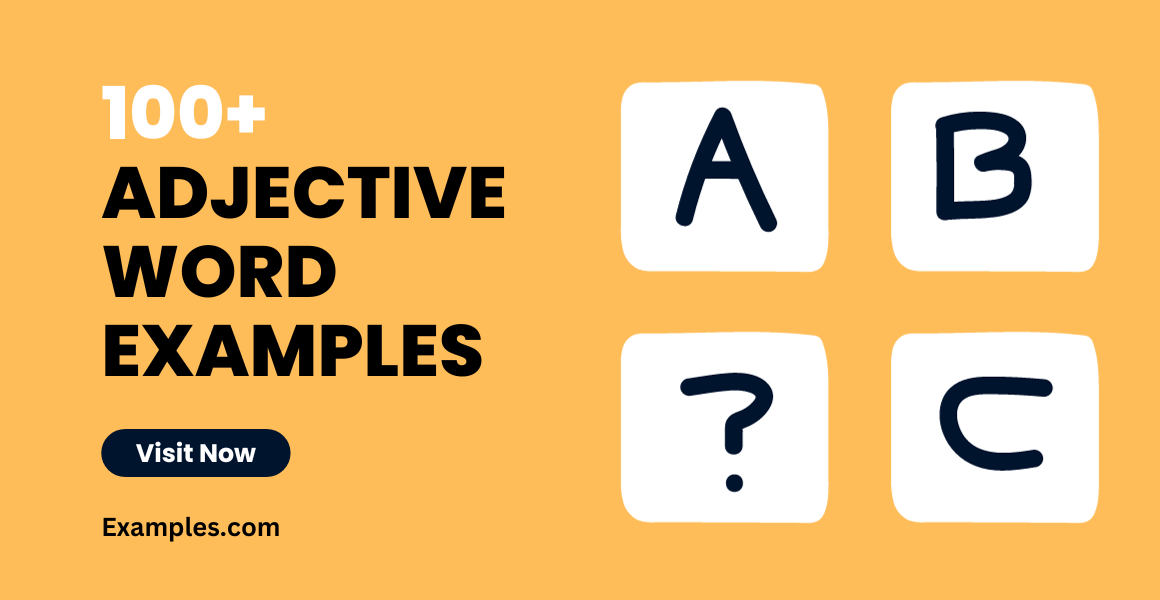99+ Adjective Examples
Do you find yourself puzzled about when and how to use adjectives? Adjectives can be a writer’s best friend when used effectively. Our comprehensive guide provides unique, relatable adjective examples and pro tips to help you master the use of adjective words. Dive in to deepen your understanding and to add that extra layer of detail to your communication.
What is an Adjective Word? – Definition
An adjective is a word that describes or modifies a noun or pronoun. It provides additional information about an object’s size, shape, age, color, origin, or material. Adjectives make your sentences more vivid and engaging, allowing you to paint a clearer picture for your readers.
What is the Best Example of an Adjective?
One of the most straightforward examples of an adjective would be the word “beautiful” in the sentence, “She has a beautiful smile.” Here, “beautiful” is describing the noun “smile,” giving us a better understanding of what kind of smile it is.
100 Unique, Distinct & Best Adjective Examples

Understanding adjectives is easier when you have various examples to consider. This comprehensive list includes 100 unique adjectives, each serving a different purpose in language to enhance your understanding and application.
- Happy
- Quick
- Blue
- Tall
- Soft
- Young
- Smart
- Brave
- Charming
- Quiet
- Elegant
- Gloomy
- Fierce
- Lazy
- Vivid
- Sharp
- Frugal
- Ancient
- Bold
- Clever
- Gentle
- Shy
- Witty
- Honest
- Nervous
- Spacious
- Bright
- Tasty
- Exotic
- Smooth
- Curly
- Sour
- Filthy
- Tiny
- Rough
- Noisy
- Grumpy
- Sleek
- Fragrant
- Fluffy
- Greedy
- Slim
- Bumpy
- Bitter
- Windy
- Dull
- Lonely
- Mysterious
- Eager
- Loud
- Calm
- Giant
- Blunt
- Icy
- Juicy
- Heavy
- Crisp
- Messy
- Warm
- Sticky
- Polite
- Crunchy
- Elusive
- Fancy
- Rapid
- Humble
- Silly
- Rigid
- Vague
- Noble
- Vibrant
- Zealous
- Meek
- Sparse
- Lively
- Generous
- Awkward
- Petite
- Foolish
- Sandy
- Wealthy
- Clumsy
- Cozy
- Savory
- Proud
- Fresh
- Crafty
- Innocent
- Hasty
- Oily
- Careful
- Tense
- Jagged
- Faint
- Angry
- Amused
- Jolly
- Breezy
- Complex
- Naive
Adjective Examples from A-Z
To better understand the extensive range of adjectives, here’s a list that spans from A to Z. Each adjective is unique, enriching your vocabulary and helping you express yourself more clearly.
- Ambitious
- Brilliant
- Cautious
- Daring
- Elegant
- Fearful
- Gracious
- Hasty
- Intriguing
- Jovial
- Kind
- Luminous
- Majestic
- Naughty
- Observant
- Pensive
- Quirky
- Radiant
- Sincere
- Thrifty
- Unbiased
- Vibrant
- Wary
- Xenial
- Youthful
- Zealous
This A-to-Z list provides a diverse set of adjectives to help you describe people, places, and things more vividly. Utilize these adjectives in your writing and speaking to make your communications more impactful.
Adjective Words Example for Kids
Understanding adjectives is an essential step for kids as they grasp the fundamentals of English grammar. Adjectives help to describe and give more information about nouns. Here are some easy-to-understand examples suited for young learners.
- Tall – The giraffe is very tall.
- Short – The mouse is short.
- Happy – She is happy today.
- Sad – He felt sad after losing the game.
- Fast – The car is fast.
- Slow – The turtle moves slow.
- Big – This is a big house.
- Small – I have a small toy.
- Hot – The sun is hot.
- Cold – Ice cream is cold.
Adjective Words Examples in English Grammar
In English grammar, adjectives serve a variety of purposes. They can describe, identify, or quantify nouns or pronouns. Adjectives can be simple, compound, or even hyphenated. Here are some examples:
- Intelligent – She is an intelligent woman.
- Rusty – The old bike is rusty.
- Beautiful – The painting is beautiful.
- Hard-working – He is a hard-working employee.
- Anxious – I was anxious about the test.
- Delicious – The food was delicious.
- First – This is the first item on the list.
- Several – There are several books on the table.
- Loud – The music was too loud.
- Soft-spoken – She is a soft-spoken person.
Remember, adjectives can go before the noun they are describing, or they can go after a linking verb like ‘is,’ ‘are,’ ‘was,’ and ‘were.’ For example:
- Preceding the noun: Happy kids
- Following a linking verb: The kids are happy.
By understanding the various types and placements of adjectives, you can make your English grammar more accurate and descriptive.
How to Use Adjective Words – Step by Step Guide
Adjectives are an indispensable part of English grammar, enhancing the quality of your sentences by adding detail and description. However, incorrect usage can lead to confusion. Here is a step-by-step guide on how to use adjectives effectively.
Step 1: Identify the Noun
Before using an adjective, you must first identify the noun you wish to describe. This can be a person, place, thing, or idea.
- Example: “The dog is running.”
Step 2: Choose the Appropriate Adjective
Choose an adjective that fits naturally and adds value to the noun you’re describing. Always aim to use the most precise adjective to convey your meaning.
- Example: “The happy dog is running.”
Step 3: Positioning
In English, adjectives usually precede the noun. However, they can also follow the noun when linked by a verb like “is,” “are,” “was,” “were.”
- Preceding the noun: “A red ball.”
- Following a linking verb: “The ball is red.”
Step 4: Coordinate Adjectives
If you’re using more than one adjective to describe a noun, separate them with a comma or the word “and.”
- Example: “She’s a smart, talented writer.” OR “She’s a smart and talented writer.”
Step 5: Order of Adjectives
When using multiple adjectives, there’s a specific order that native speakers instinctively follow. The general order is: quantity, quality, size, age, shape, color, proper adjective (often nationality, other place of origin, or material), and purpose or qualifier.
- Example: “She wore a beautiful long red silk dress.”
Step 6: Comparisons
When comparing two or more nouns, use comparative or superlative forms of the adjective.
- Comparative: “She is taller than him.”
- Superlative: “She is the tallest person in the room.”
Step 7: Review and Revise
Always review your sentences to ensure that the adjectives used are enhancing, not complicating, your message. Remove any unnecessary adjectives and make sure you’ve followed the guidelines for proper usage.
By adhering to these steps, you’ll be able to employ adjectives in a way that makes your sentences more engaging, precise, and descriptive.
Tips for Using Adjective Words
- Limit Numbers: Don’t use too many adjectives in one sentence; it can make the sentence difficult to follow.
- Order Matters: When using multiple adjectives, the order in which they appear often sounds more natural if it follows the “royal order” of adjectives: opinion, size, age, shape, color, origin, material, and purpose.
- Synonyms are Handy: Don’t get stuck on one adjective. Knowing synonyms can add variety to your speech and writing.
By understanding and applying these tips and guidelines, you can significantly enhance your writing and communication skills. Adjectives, when used correctly, can transform an ordinary sentence into a piece of art. So go ahead and sprinkle a little adjective magic into your next writing project!



